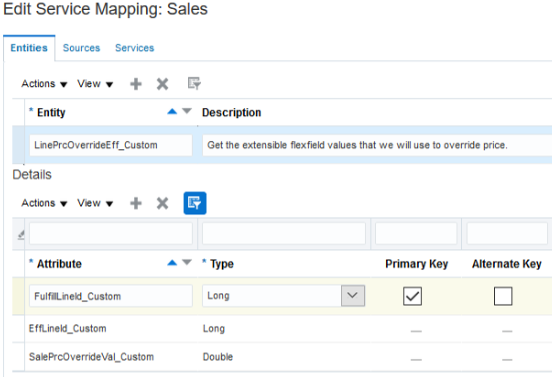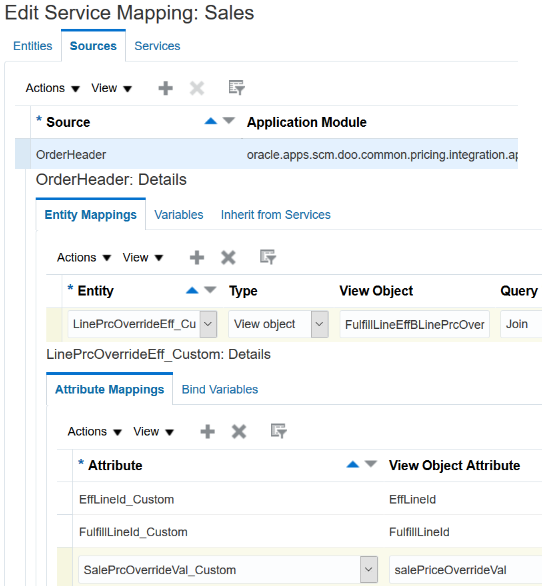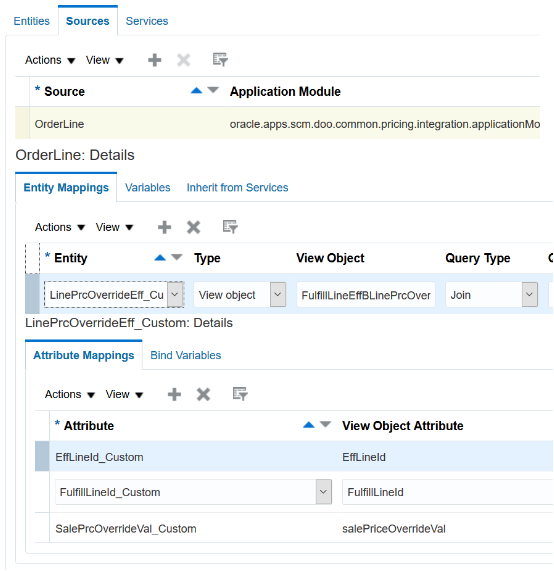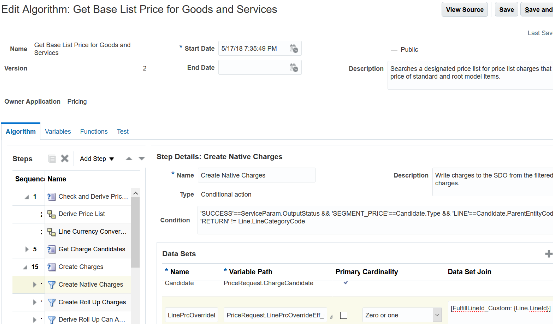Override Base List Price
Set up Oracle Pricing so it uses the value from an extensible flexfield to override the base list price.
Use this procedure only with a standard item. You can't use it with a coverage item or subscription item.
In this example, you define an extensible flexfield that displays in the Order Management work area. You then use the value that the Order Entry Specialist enters in the flexfield to override the Sale Price charge.
Summary of the Set Up
-
Set up the extensible flexfield.
-
Modify the pricing algorithm.
-
Test your set up.
Set Up the Extensible Flexfield
-
Make sure you have the privileges that you need to administer Order Management.
Don't sign in with pricing privileges. You can't use them to define an extensible flexfield.
-
Go to the Setup and Maintenance work area, then go to the task:
-
Offering: Order Management
-
Functional Area: Orders
-
Task: Manage Order Extensible Flexfields
This example assumes you're implementing the Order Management offering. If you're using a different offering, then click it instead of Order Management.
-
-
Modify the extensible flexfield.
-
On the Manage Order Extensible Flexfields page, enter the values, then click Search.
Attribute
Value
Name
Fulfillment Line Information
Flexfield Code
DOO_FULFILL_LINES_ADD_INFO
-
Click Actions > Edit.
-
Click Manage Contexts.
-
On the Manage Contexts page, click Actions > Create.
-
On the Create Context page, set values.
Attribute
Value
Display Name
LinePrcOverride
Code
LinePrcOverride
API Name
Lineprcoverride
Enabled
Contains a check mark
Behavior
Single Row
-
In the Context Usages area, click Actions > Create, set the values, then click Save.
Attribute
Value
Name
Additional Fulfillment Line Information
View Privileges
None
Edit Privileges
None
-
In the Context Sensitive Segments area, click Actions > Create.
-
On the Create Segment page, set the values, then click Save and Close.
Attribute
Value
Name
SalePrcOverrideVal
Code
SalePrcOverrideVal
API Name
saleprcoverrideval
Enabled
Contains a check mark.
Data Type
Number
Table Column
Select any column that's available.
Value Set
15 Digit Number
Prompt
SalePrcOverrideVal
-
On the Edit Context page, click Save and Close.
-
On the Manage Contexts page, click Save and Close.
-
On the Edit Extensible Flexfield page, click Save and Close.
-
-
Deploy the extensible flexfield.
-
On the Manage Order Extensible Flexfields page, click Actions > Deploy Flexfield.
-
Wait for the deployment dialog to indicate that deployment successfully finished, then click OK.
-
Click Actions > Download Flexfield Archive, wait for the dialog to indicate that the archive successfully finished, then click Download.
-
Save file 10008_DOO_FULFILL_LINES_ADD_INFO.zip to your local hard drive, extract it, then navigate to this folder.
oracle\apps\scm\doo\processOrder\flex\fulfillLineContextsB\view\ -
Open FulfillLineEffBLinePrcOverrideprivateVO.xml.
-
Add Extensible Flexfield to Service Mapping
You define a service mapping that maps values from the extensible flexfield into Pricing.
Add the extensible flexfield to the service mapping.
-
Sign out, then sign in with the privileges that you need to administer pricing.
-
Go to the Pricing Administration work area, then click Tasks > Manage Service Mappings.
-
On the Manage Service Mappings page, in the Name column, click Sales.
-
Define the entities.
-
On the Edit Service Mappings page, on the Entities tab, click Action > Add Row, then set the values.
Attribute
Value
Entity
LinePrcOverrideEff_Custom
Description
Get the extensible flexfield values that we will use to override price.
-
In the Details area, add attributes, then click Save.
Attribute
Type
Primary Key
FulfillLineId_Custom
Long
Contains a check mark.
EffLineId_Custom
Long
Does not contain a check mark.
SalePrcOverrideVal_Custom
Decimal
Does not contain a check mark.
For example:

-
Click Services, then click the row that contains this value.
Attribute
Value
Service
PriceSalesTransaction
-
In the Details area, click Actions > Add Row, then set these values.
Entity
Read
Write
LinePrcOverrideEff_CustomContains a check mark.
Does not contain a check mark.
This step creates a relationship between Pricing and the entity that you use to send values from the extensible flexfield.
-
In the LinePrcOverrideEff_Custom Entities area, add attributes, then click Save.
Attribute
Read
Write
EffLineId_Custom
Contains a check mark.
Does not contain a check mark.
FulfillLineId_Custom
Contains a check mark.
Does not contain a check mark.
SalePrcOverrideVal_Custom
Contains a check mark.
Does not contain a check mark.
-
-
Set up the source for the order header.
-
Click Sources, then click the row that includes the value.
Attribute
Value
Source
OrderHeader
-
On the Entity Mapping tab, click View > Columns, then add a check mark to Joined Entity and Joined Entity Attribute.
-
Click Actions > Add Row, set the values, then click Save.
Attribute
Value
Entity
LinePrcOverrideEff_Custom
Type
View Object
View Object
FulfillLineEffBLinePrcOverrideprivateVO
Make sure the value you enter matches exactly the value you noticed earlier in this topic when you examined the flexfield archive. Don't include the
.xmlextension.Query Type
Join
Query Attribute
FulfillLineId
Joined Entity
Line
It might be necessary to click another row, and then return to this row to get the joined entity attributes to populate values.
Joined Entity Attribute
LineId
-
In Details area LinePrcOverrideEff_Custom, add the attributes, then click Save.
Attribute
View Object Attribute
EffLineId_Custom
EffLineId
FulfillLineId_Custom
FulfillLineId
SalePrcOverrideVal_Custom
salePriceOverrideVal
Make sure the value you enter matches exactly the value you noticed in tag ViewAttribute Name of the flexfield archive you examined earlier in this topic. For example,
ViewAttribute Name="salePriceOverrideVal".This step sets up Pricing to read extensible flexfield values from the public view object that Order Management sends to Pricing when the Order Entry Specialist uses the Price Order action or saves the sales order.
For example:

-
-
Set up the source for the order line.
-
In the Sources area, click the row that includes the value.
Attribute
Value
Source
OrderLine
-
On the Entity Mapping tab, click Actions > Add Row, set the values, then click Save.
Attribute
Value
Entity
LinePrcOverrideEff_Custom
Type
View Object
View Object
FulfillLineEffBLinePrcOverrideprivateVO
Make sure the value you enter matches exactly the value you noticed earlier in this topic when you examined the flexfield archive.
Query Type
Join
Query Attribute
FulfillLineId
Joined Entity
Line
Joined Entity Attribute
LineId
This step maps the extensible flexfield attributes in the public view object. It sets up Pricing to read extensible flexfield values from the public view object that Order Management sends to Pricing when Order Management updates the line quantity or shipping attributes on the order line.
-
In the Details area for HeaderPricingEff_Custom, add the attributes.
Attribute
View Object Attribute
EffLineId_Custom
EffLineId
FulfillLineId_Custom
FulfillLineId
SalePrcOverrideVal_Custom
salePriceOverrideVal
Make sure the value you enter matches exactly the value you noticed in the ViewAttribute Name tag of the flexfield archive you examined earlier in this topic. For example,
ViewAttribute Name="salePriceOverrideVal".This step sets up Pricing to read extensible flexfield values from the public view object that Order Management sends to Pricing when Order Management updates the quantity attribute or a shipping attribute on the order line.
For example:

-
-
Click Save and Close > Done.
Modify Pricing Algorithm
-
Click Tasks > Manage Algorithms.
-
On the Manage Algorithms page, select a published version of this pricing algorithm, such as Version 1.
Attribute
Value
Name
Get Base List Price For Goods And Services
-
Click Actions > Create Version, then wait for the page to display your In Progress version, such as Version 2
-
Open your In Progress version for editing.
-
On the Edit Algorithm page, on the Algorithm tab, expand step Create Charges, then click step Create Native Charges.
You will modify this step so it references the extensible flexfield that contains the override value.
-
In the Data Sets area, add this data set.
Attribute
Value
Name
LinePrcOverrideEff
Variable Path
PriceRequest.LinePrcOverrideEff_Custom
Cardinality
Zero or one
Data Set Join
[FulfillLineId_Custom: {Line.LineId}]
For example:

-
In the Default Action area, in the Actions window, replace the code.
Old Code
New Code
Ch.CurrencyCode = Line.AppliedCurrencyCode//Ch.CurrencyCode = Line.AppliedCurrencyCode //Base List Price Override if (null != LinePrcOverrideEff?.SalePrcOverrideVal_Custom) { Ch.CurrencyCode = Header.AppliedCurrencyCode Line.AppliedCurrencyCode = Header.AppliedCurrencyCode Ch.NeedsCostPlus = false //clear out the tier and matrix adjustments Candidate.unset('TieredPricingHeaderId') Candidate.unset('AttributePricingMatrixId') } else { Ch.CurrencyCode = Line.AppliedCurrencyCode Ch.NeedsCostPlus = ('COST'==CalculationMethod) } -
Comment this code.
Old Code
New Code
Ch.NeedsCostPlus = ('COST'==CalculationMethod)//Ch.NeedsCostPlus = ('COST'==CalculationMethod)Here's the complete, revised code.
Ch = Charge.insert([ChargeId:++ServiceParam.ChargeIdCntr, LineId:Line.LineId, ParentEntityId:Candidate.ParentEntityId, ParentEntityCode:'LINE']) if ( CanAdjustFlag!=null ) Ch.CanAdjustFlag = ('Y'==CanAdjustFlag) Ch.ChargeAppliesTo = Candidate.ChargeAppliesTo Ch.ChargeDefinitionCode = Candidate.ChargeDefinitionCode Ch.ChargeDefinitionId = ChargeDefinitionId Ch.ChargeSubtypeCode = ChargeSubtypeCode Ch.ChargeTypeCode = ChargeTypeCode // Set the CompSeqCntr as Long instead of Integer Ch.CompSeqCntr = 1000L //Ch.CurrencyCode = Line.AppliedCurrencyCode //Base List Price Override if (null != LinePrcOverrideEff?.SalePrcOverrideVal_Custom) { Ch.CurrencyCode = Header.AppliedCurrencyCode Line.AppliedCurrencyCode = Header.AppliedCurrencyCode Ch.NeedsCostPlus = false //clear out the tier and matrix adjustments Candidate.unset('TieredPricingHeaderId') Candidate.unset('AttributePricingMatrixId') } else { Ch.CurrencyCode = Line.AppliedCurrencyCode Ch.NeedsCostPlus = ('COST'==CalculationMethod) } Ch.EstimatedPricedQuantityFlag = ('USAGE'==PriceTypeCode || 'RECURRING_USAGE'==PriceTypeCode) Ch.EstimatedUnitPriceFlag = Ch.EstimatedPricedQuantityFlag Ch.PrimaryFlag = false Ch.RollupFlag = false //Ch.NeedsCostPlus = ('COST'==CalculationMethod) Ch.NeedsMargin = ('Y'==CalculateMarginFlag) if (PricePeriodicityCode!=null) Ch.PricePeriodicityCode = PricePeriodicityCode Ch.PriceTypeCode = PriceTypeCode if ( 'USAGE'==PriceTypeCode || 'RECURRING_USAGE'==PriceTypeCode ) { // PricedQty should be null if estimated usage quantity is not passed in PricedQty = (Ci?.EstimatedUsageQuantity!=null ? (Ci.PerUnitUsageFlag ? (Line.ExtendedQuantity?.Value ?: Line.LineQuantity.Value) : 1)*Ci?.EstimatedUsageQuantity?.Value : null) } else { PricedQty = Line.ExtendedQuantity?.Value ?: Line.LineQuantity.Value } if ( PricedQty != null ) { Ch.createDataObject('PricedQuantity') Ch.PricedQuantity.Value = PricedQty Ch.PricedQuantity.UnitCode = PricingUomCode Ch.PricedQuantityUOMCode = PricingUomCode } Ch.RunningUnitPrice = 0 if (Ci?.UsagePeriodCode!=null) Ch.UsagePeriodCode = Ci.UsagePeriodCode if (Ch.UsagePeriodCode!=null && Candidate.UsagePeriodCode!=null) Ch.UsagePeriodCode = Candidate.UsagePeriodCode if (UsageUomCode!=null) Ch.UsageUOMCode = UsageUomCode Ch.TaxIncludedFlag = false finer(AlgmName+': created native charge '+Ch.ChargeId+' ('+Ch.PriceTypeCode+', '+Ch.ChargeTypeCode+', '+Ch.ChargeSubtypeCode+') for line '+Line.LineId) // Needed to write charge component Candidate.ChargeId = Ch.ChargeId // Initialize for tiered pricing if (Candidate.TieredPricingHeaderId != null) { TierQ.insert([TieredPricingHeaderId:Candidate.TieredPricingHeaderId, ChargeId:Ch.ChargeId, OriginId:Line.LineId, OriginType:'LINE']) } // Initialize for attribute-based pricing if (Candidate.AttributePricingMatrixId != null) { MatrixQ.insert([DynamicMatrixId:Candidate.AttributePricingMatrixId, ParentEntityId:Ch.ChargeId, FromCurrencyCode:Ch.CurrencyCode, ParentEntityCode:'CHARGE']) } // Coverage Duration being calculated if its a Phantom Line if ('COVERED_STANDARD' == Line.ItemType && Line.PhantomFlag) { if (CoverageAssociation != null) { Ch.createDataObject('CoverageDuration') Ch.CoverageDuration.Value = CoverageAssociation.CoverageDuration.Value Ch.CoverageDuration.UnitCode = CoverageAssociation.CoverageDuration.UnitCode Ch.CoverageDurationUOMCode = CoverageAssociation.CoverageDurationUOMCode } Ch.LineId = CoverageLine.LineId } -
Click the Create Charge Components step.
You will modify this step so it references the extensible flexfield that contains the override value, then use this value to calculate the unit price.
-
In the Data Sets area, add this data set.
Attribute
Value
Name
LinePrcOverrideEff
Variable Path
PriceRequest.LinePrcOverrideEff_Custom
Cardinality
Zero or one
Data Set Join
[FulfillLineId_Custom: {Line.LineId}]
-
In the Default Action area, locate this code.
Comp.createDataObject('UnitPrice') -
Add this code immediately under the code you just located.
//Base List Price Override if(Candidate.CalculationMethod == 'COVERED_ITEM_PRICE_PERCENT') { fine({'UnitPrice Calc - Cand.CalculationAmount: '+Candidate.CalculationAmount+' CoverageBasis: '+Candidate.CoverageBasisValue}) Comp.UnitPrice.Value = Candidate.CalculationAmount * Candidate.CoverageBasisValue/ 100 Ch.HasPercentPriceFlag = true } else { //Base List Price Override if (LinePrcOverrideEff?.SalePrcOverrideVal_Custom != null) Comp.UnitPrice.Value = LinePrcOverrideEff.SalePrcOverrideVal_Custom else Comp.UnitPrice.Value = Candidate.BasePrice } Comp.UnitPrice.CurrencyCode = Line.AppliedCurrencyCode Comp.CurrencyCode = Line.AppliedCurrencyCode // convert currency if needed if ( Line.FromCurrencyCode!=null && Line.FromCurrencyCode!=Line.AppliedCurrencyCode ) { if (ConvRate?.MessageTypeCode == 'ERROR') { finest('creating line message') Line.MessageTypeCode = 'ERROR' Ch.MessageTypeCode = 'ERROR' def messageMap = [ParentEntityCode:'LINE', ParentEntityId:Line.LineId, HeaderId:Header.HeaderId, MessageText:ConvRate.PrcErrorMessage] msg = Message.locate(messageMap) if ( msg==null ) { // create new error message for Line msg = Message.insert(messageMap) msg.PricingMessageId = getNextId() msg.MessageName = ConvRate.PrcMessageName msg.MessageTypeCode = Line.MessageTypeCode } } else { Ch.CurrencyCode = Line.AppliedCurrencyCode Comp.UnitPrice.Value *= ConvRate.ConversionRate?:1 } } //end base price overrideHere's the complete, revised code.
Comp = ChargeComponent.insert([ChargeComponentId:++ServiceParam.ChargeComponentIdCntr, ChargeId: Ch.ChargeId]) Comp.PriceElementCode = ElementParam Comp.PriceValidFrom = Line.PricingDate if ( EndDate!=null ) Comp.PriceValidUntil = EndDate Comp.SequenceNumber = (Long) Ch.CompSeqCntr++ Comp.SourceId = Candidate.PriceListChargeId Comp.SourceTypeCode = 'PRICE_LIST_CHARGE' fine({'Before UnitPrice Calc - CalcMethod: '+Candidate.CalculationMethod}) Comp.createDataObject('UnitPrice') //Base List Price Override if(Candidate.CalculationMethod == 'COVERED_ITEM_PRICE_PERCENT') { fine({'UnitPrice Calc - Cand.CalculationAmount: '+Candidate.CalculationAmount+' CoverageBasis: '+Candidate.CoverageBasisValue}) Comp.UnitPrice.Value = Candidate.CalculationAmount * Candidate.CoverageBasisValue/ 100 Ch.HasPercentPriceFlag = true } else { //Base List Price Override if (LinePrcOverrideEff?.SalePrcOverrideVal_Custom != null) Comp.UnitPrice.Value = LinePrcOverrideEff.SalePrcOverrideVal_Custom else Comp.UnitPrice.Value = Candidate.BasePrice } Comp.UnitPrice.CurrencyCode = Line.AppliedCurrencyCode Comp.CurrencyCode = Line.AppliedCurrencyCode // convert currency if needed if ( Line.FromCurrencyCode!=null && Line.FromCurrencyCode!=Line.AppliedCurrencyCode ) { if (ConvRate?.MessageTypeCode == 'ERROR') { finest('creating line message') Line.MessageTypeCode = 'ERROR' Ch.MessageTypeCode = 'ERROR' def messageMap = [ParentEntityCode:'LINE', ParentEntityId:Line.LineId, HeaderId:Header.HeaderId, MessageText:ConvRate.PrcErrorMessage] msg = Message.locate(messageMap) if ( msg==null ) { // create new error message for Line msg = Message.insert(messageMap) msg.PricingMessageId = getNextId() msg.MessageName = ConvRate.PrcMessageName msg.MessageTypeCode = Line.MessageTypeCode } } else { Ch.CurrencyCode = Line.AppliedCurrencyCode Comp.UnitPrice.Value *= ConvRate.ConversionRate?:1 } } //end base price override Ch.RunningUnitPrice+=Comp.UnitPrice.Value if ( Ch.PricedQuantity!=null ) { Comp.createDataObject('ExtendedAmount') Comp.ExtendedAmount.Value = Comp.UnitPrice.Value*Ch.PricedQuantity.Value Comp.ExtendedAmount.CurrencyCode = Comp.UnitPrice.CurrencyCode def fromUomCode = null def fromUomValue = null if ( 'COVERED_STANDARD' == Line.ItemType && Line.PhantomFlag ){ fromUomCode = Ch.CoverageDurationUOMCode fromUomValue = Ch.CoverageDuration.Value }else if ( Line.ItemType in ['STANDARD', 'COMPONENT', 'ROOT'] && null != Line.ServiceDuration?.Value && null != Line.ServiceDurationPeriodCode ) { fromUomCode = Line.ServiceDurationPeriodCode fromUomValue = Line.ServiceDuration?.Value } if (null != fromUomCode && null != fromUomValue) { Comp.createDataObject('CoverageExtendedAmount') if ('ONE_TIME' == Ch.PriceTypeCode) { Comp.CoverageExtendedAmount.Value = Comp.ExtendedAmount.Value }else if ('RECURRING' == Ch.PriceTypeCode) { if (Ch.PricePeriodicityCode != fromUomCode) { def fromUom = getOKCUomMappings(fromUomCode) def toUom = getOKCUomMappings(Ch.PricePeriodicityCode) if(null == fromUom || null == toUom){ Line.MessageTypeCode = 'ERROR' Ch.MessageTypeCode = Line.MessageTypeCode def uomMsg = Message.insert([ MessageName:'QP_PDP_PARTIAL_PERIOD_UOM_NA', MessageTypeCode: 'ERROR', ErrorType:(Ch.HasPercentPriceFlag?'PERCENTAGE':'AMOUNT'), PricingMessageId: getNextId(), ParentEntityCode: 'LINE', ParentEntityId: Line.LineId, HeaderId: Header.HeaderId]) def chargeName = getChargeDefinitionName(Ch.ChargeDefinitionId) if(null == fromUom){ def fromUomTranslation = getUomTranslation(fromUomCode) uomMsg.MessageText = getFndMessage('QP', 'QP_PDP_PARTIAL_PERIOD_UOM_NA', ['CHARGE_DEF_NAME':chargeName?.Name , 'UOM_CODE':fromUomTranslation?.UnitOfMeasure]) } if(null == toUom){ def toUomTranslation = getUomTranslation(Ch.PricePeriodicityCode) uomMsg.MessageText = getFndMessage('QP', 'QP_PDP_PARTIAL_PERIOD_UOM_NA', ['CHARGE_DEF_NAME':chargeName?.Name , 'UOM_CODE':toUomTranslation?.UnitOfMeasure]) } } if(null != fromUom && null != toUom){ durationConvRate = getDurationConversionRate(fromUom, toUom, CoverageAssociation, Line) if(null == durationConvRate){ def fromUomTranslation = getUomTranslation(fromUomCode) def toUomTranslation = getUomTranslation(Ch.PricePeriodicityCode) Line.MessageTypeCode = 'ERROR' Ch.MessageTypeCode = 'ERROR' Message.insert([ MessageName:'QP_PDP_PARTIAL_PERIOD_CONVERS', MessageText: getFndMessage('QP', 'QP_PDP_PARTIAL_PERIOD_CONVERS', ['UOM': toUomTranslation?.UnitOfMeasure, 'COV_UOM': fromUomTranslation?.UnitOfMeasure]), MessageTypeCode: Line.MessageTypeCode, ErrorType:(Ch.HasPercentPriceFlag?'PERCENTAGE':'AMOUNT'), PricingMessageId: getNextId(), ParentEntityCode: 'LINE', ParentEntityId: Line.LineId, HeaderId: Header.HeaderId]) } else { if( RollupCh != null ) RollupCh.PartialPeriodDurationConversionRate = durationConvRate Ch.PartialPeriodDurationConversionRate = durationConvRate Comp.CoverageExtendedAmount.Value = Comp.ExtendedAmount?.Value * durationConvRate } } } else Comp.CoverageExtendedAmount.Value = Comp.ExtendedAmount.Value * fromUomValue } Comp.CoverageExtendedAmount.CurrencyCode = Comp.ExtendedAmount.CurrencyCode } } finer(AlgmName+': created '+Comp.PriceElementCode+' charge component '+Comp.ChargeComponentId+' with unit price '+Comp.UnitPrice.Value+' '+Comp.UnitPrice.CurrencyCode+', extended amount '+(Comp.ExtendedAmount!=null ? Comp.ExtendedAmount.Value+' '+Comp.ExtendedAmount.CurrencyCode : null)) -
Click Save and Close.
-
On the Manage Algorithms page, click Actions > Publish.
Test Your Set Up
-
On the Manage Algorithms page, open Price Sales Transaction for editing.
-
On the Edit Algorithm page, click Test.
-
Click Actions > Add Row, then set the value.
Attribute
Value
Test Case Name
Test Base Price Override
-
In the Test Input area, in the row that contains PriceRequest in column Variable Name, click the pencil in the Variable Value column.
-
In the Edit Variable dialog, delete all the code, then add this code:
<?xml version="1.0" encoding="UTF-8"?> <PriceRequestInternal:PriceRequestInternalType xmlns:ns0="http://xmlns.oracle.com/adf/svc/types/"xmlns:PriceRequestInternal="http://xmlns.oracle.com/apps/scm/pricing/priceExecution/pricingProcesses/pricingInternal/PricingInternal" xmlns:xsi="http://www.w3.org/2001/XMLSchema-instance" xsi:type="PriceRequestInternal:PriceRequestInternalType"> <PriceRequestInternal:Header> <PriceRequestInternal:CustomerId>1028144</PriceRequestInternal:CustomerId> <PriceRequestInternal:HeaderId>101</PriceRequestInternal:HeaderId> <PriceRequestInternal:CalculatePricingChargesFlag>true</PriceRequestInternal:CalculatePricingChargesFlag> <PriceRequestInternal:CalculateShippingChargesFlag>false</PriceRequestInternal:CalculateShippingChargesFlag> <PriceRequestInternal:CalculateTaxFlag>false</PriceRequestInternal:CalculateTaxFlag> <PriceRequestInternal:SellingBusinessUnitId>103</PriceRequestInternal:SellingBusinessUnitId> <PriceRequestInternal:SellingLegalEntityId>204</PriceRequestInternal:SellingLegalEntityId> <PriceRequestInternal:TransactionTypeCode>ORDER</PriceRequestInternal:TransactionTypeCode> </PriceRequestInternal:Header> <PriceRequestInternal:PricingServiceParameter> <PriceRequestInternal:PricingContext>SALES</PriceRequestInternal:PricingContext> </PriceRequestInternal:PricingServiceParameter> <PriceRequestInternal:Line> <PriceRequestInternal:HeaderId>101</PriceRequestInternal:HeaderId> <PriceRequestInternal:InventoryItemId>100000017351102</PriceRequestInternal:InventoryItemId> <PriceRequestInternal:InventoryOrganizationId>204</PriceRequestInternal:InventoryOrganizationId> <PriceRequestInternal:LineId>1001</PriceRequestInternal:LineId> <PriceRequestInternal:LineCategoryCode>ORDER</PriceRequestInternal:LineCategoryCode> <PriceRequestInternal:LineQuantity unitCode="Ea" xmlns:tns="http://xmlns.oracle.com/adf/svc/errors/">2</PriceRequestInternal:LineQuantity> <PriceRequestInternal:LineQuantityUOMCode>Ea</PriceRequestInternal:LineQuantityUOMCode> <PriceRequestInternal:LineTypeCode>ORA_BUY</PriceRequestInternal:LineTypeCode> </PriceRequestInternal:Line> <PriceRequestInternal:LinePrcOverrideEff_Custom> <PriceRequestInternal:SalePrcOverrideVal_Custom>1000</PriceRequestInternal:SalePrcOverrideVal_Custom> <PriceRequestInternal:FulfillLineId_Custom>1001</PriceRequestInternal:FulfillLineId_Custom> <PriceRequestInternal:EffLineId_Custom>123</PriceRequestInternal:EffLineId_Custom> </PriceRequestInternal:LinePrcOverrideEff_Custom> <PriceRequestInternal:ChangeSummary logging="false" xmlns:sdo="commonj.sdo"/> </PriceRequestInternal:PriceRequestInternalType>where
Value
Is An Example For
1028144
CustomerId
103
SellingBusinessUnitId
204
SellingLegalEntityId
100000017351102
InventoryItemId
204
InventoryOrganizationId
Ea
unitCode
Ea
LineQuantityUOMCode
<PriceRequestInternal:SalePrcOverrideVal_Custom>1000</PriceRequestInternal:SalePrcOverrideVal_Custom>Specifies to override the net price to $1000. Modify this value for your test, as necessary.
To get the values that you must use in your environment, see section Getting Identifiers for Test Payloads, below in this topic.
-
Click Run Test > Test Output, then make sure the output payload includes the details you expect.
-
Verify that Last Execution Status displays Succeeded, or a similar success indication.
If it displays Failure, then click Show Exception Details to examine and troubleshoot.
If you receive this error, then use an XML editor to validate that your code uses the correct XML format.
Error: Unable to parse the variable[PriceRequest] using the service definition [Sales.PriceRequestInternal]. Please check the variable value or service schema -
Click Save and Close.
-
On the Manage Algorithms page, click Actions > Publish.
Create a Test Sales Order
-
Sign out, then sign in with the privileges that you need to manage sales orders.
-
Click Create Order, enter values for the order header, add an order line, then add a value in your extensible flexfield, such as 199.
-
Save the sales order, or click Actions > Reprice Order.
-
Verify that the price of the item includes the price you entered in the extensible flexfield and SalePrcOverrideVal.
Get Identifiers for Test Payloads
-
Make sure you have the privileges that you need to manage sales orders.
Go to the Order Management work area, then create a sales order.
-
Set attributes to values you must test.
Attribute
Example Value
Customer
Fantastic Laptops
Business Unit
Vision Operations
-
Add an order line that includes the item you're testing. For this example, add AS54888.
-
Click Submit, then notice the sales order number that Order Management creates, such as 12345.
-
-
Get values for the sales order header. Run a SQL query on the database you use to store the sales order that you created in step 1.
select header_id, sold_to_party_id as CustomerId, org_id as SellingBusinessUnitId, legal_entity_id as SellingLegalEntityId from doo_headers_all where Order_Number = $12345;where
-
12345 is the order number you noted in step 1.
-
The query returns values that you can use in your payload for these header attributes.
Value in SQL
Provides Value for Attribute in Test Payload
Example Values
sold_to_party_id
Header.CustomerId
Header_id equals 100413 and CustomerId equals 1006.
org_id
Header.SellingBusinessUnitId
SellingBusinessUnitId equals 204.
legal_entity_id
Header.SellingLegalEntityId
SellinglegalEntityId equals 204.
-
-
Get values for the order line. Run this SQL query.
select inventory_item_id as InventoryItemId, inventory_organization_id as InventoryOrganizationId, ordered_uom as LineQuantityUOMCode from doo_fulfill_lines_all where header_id = $56789;where
-
56789 is the header Id in the query result from step 2.
-
The query returns values that you can use in your payload for these order line attributes.
Value in SQL
Provides Value for Attribute in Test Payload
Example Values
inventory_item_id
Line.InventoryItemId
Header_id equals 100413 and InventoryItemId equals 149.
inventory_organization_id
Line.InventoryOrganizationId
InventoryOrganizationId equals 204.
ordered_uom
Line.LineQuantity.UOMCode
Note that you must replace UOMCode in two different locations in the payload. In this example, the value is Ea.
LineQuantityUOMCode equals USD.
-